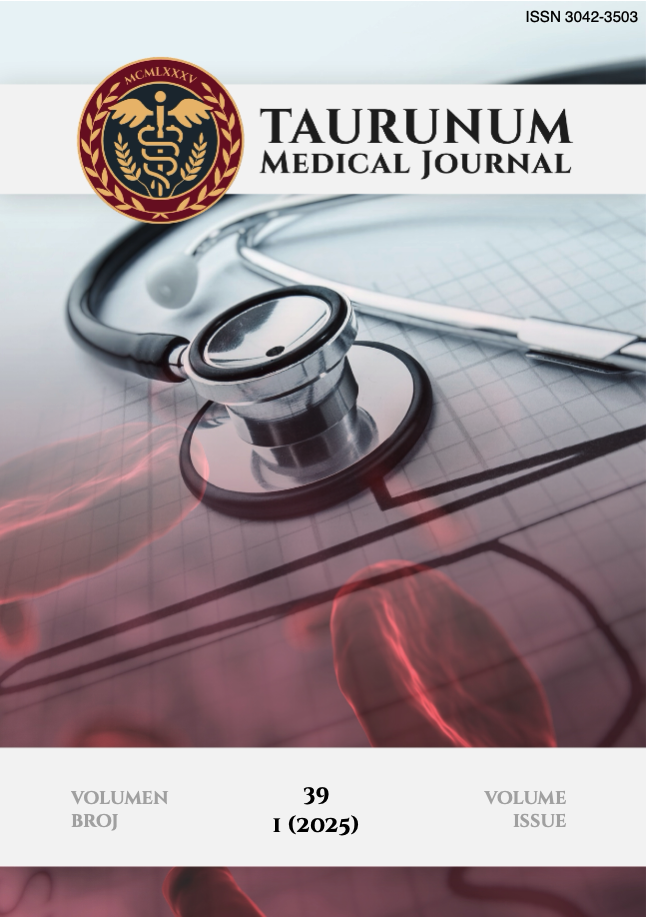Current issue

Volume 39, Issue 1, 2025
Online ISSN: 3042-3511
ISSN: 3042-3503
Volume 39 , Issue 1, (2025)
Published: 31.03.2025.
Open Access
Welcome to Issue 39, No. 1 – the first of our two annual publications for this year. Inside, you'll find a curated selection of articles. Start your year with the essential knowledge and perspectives offered in this timely edition
All issues
Contents
31.03.2025.
Review Article
The indications for admission to the Department of Internal Medicine Intensive Care at the Clinical Hospital Center Zemun
Intensive Care Units (ICUs) are inevitably positioned at the top of the treatment pyramid for patients with acute and life-threatening conditions according to current medical practice. The number of critically ill patients has dramatically increased owing to better treatment quality, a longer life expectancy, and the impact of modern technologies. This has raised concerns regarding the intensive care and surveillance of these patients. Compared to colleagues in non- intensive care services, the profiles of physicians and nurses/technicians working ICUs differ considerably in their patients’ approach and skills performance. Specific indications for ICU admission have been established due to the restricted number of available ICU beds. These patients are transferred to semi-intensive care (SICUs) services within the departments that correspond to their pathology once their critical condition has stabilized. The ICU patients cannot be fully recovered, but can have their conditions stabilized to the point where they may receive further treatment outside of the ICU. Thus, ICUs and SICUs represent one functional unit. The aim of this review is to present the indications for admission to the Department of Internal Medicine ICU of the Clinical Hospital Center Zemun.
Bojan Mitrović, Ratko Tomašević, Saša Pančevački, Milica Radović, Svetozar Mijušković, Zoran Gluvić
01.12.2020.
Case Report
Fatal idiopathic syndrome of inappropriate antidiuresis: two case reports
Hyponatremia is an electrolyte disorder frequently encountered in clinical practice. The first step in the diagnostic evaluation of hyponatremia is the volume assessment (clinical estimation of hypo/hypervolemia presence). In the cases of euvolemic hyponatremia, followed by decreased plasma osmolality (<275mOsm/kg) with urine osmolality >100mOsm/kg, urine sodium >30mmol/L along with normal intake of salt and water, preserved pituitary, adrenal, thyroid, adrenal function as well as no recent use of diuretics, syndrome of inappropriate diuresis (SIAD) is diagnosed. In symptomatic, especially acute hyponatremia, careful and gradual substitution by 3 (10) % sodium-chloride infusion is advised with liquid intake restriction, the administration of demeclocycline, urea, or vaptans, as well as causal treatment of SIAD. SIAD is often transient and etiologically clear. In this paper, we present two cases with idiopathic, chronic SIAD with poor outcomes. During the diagnostic follow-up, the cause of SIAD was not found. The autopsy finding was also adverse. In most cases, euvolemic hyponatremia in patients with chronic, idiopathic SIAD is an ominous sign.
Zoran Gluvic, Mitrovic Bojan, Pancevacki Sasa, Lackovic Milena, Samardzic Vladimir, Milan Obradovic, Isenovic R Esma
01.12.2017.
Review Article
Uhvaćen je stari lisac: Stafi lokokni toksični šok sindrom kod odraslog muškarca -prikaz slučaja
Stafilokokni toksični šok sindrom (STŠS) se obično javlja kod novorođenčadi i dece, ali se povremeno može javiti i kod odraslih. U tom slučaju, obično ukazuje na disfunkciju imunog sistema. Prikazan je slučaj kritično-obolelog odraslog muškarca sa STŠS i simptomima i znacima životno-ugrožavajuće sistemske infekcije (hemodinamska nestabilnost, akutna insuficijencija bubrega, konfuzija). Nakon završenog lečenja (anti-stafilokoni antibiotici, hemodijaliza, vazopresori, suportivna i simptomatska terapija), postignuta je potpuna remisija kod obolelog. Pravovremena dijagnostika i adekvatan tretman je glavno uporište u lečenju STŠS kod odraslih.
Zoran Gluvić, Bojan Mitrović, Milena Lačković, Vladimir Samardžić, Dunja Jakšić, Aleksandar Pavlović, Ratko Tomašević, Milan Obradović, Esma Isenović
01.07.2017.
Current News
Primena APACHE II skora u jedinicama medicinskih intenzivnih nega
Bojan Mitrović, Zoran Gluvić, Jević N, Jević N, Aleksandar N Nešković
01.12.2017.
Original Article
The team management of patient suffered of acute severe dyslipidaemic pancreatitis - the experience of one tertiary health centre
This article presents a case of patient with acute and complicated dyslipidaemic pancreatitis, managed by team, consisted of the endocrinologists, gastroenterologists and transfusiologists. Dyslipidaemia, predominantly type IV, is a common cause of acute pancreatitis in young patients, especially in the cases of poor compliance (irregular taking of recommended fibrates and failure to comply with the dietary regime). The treatment of acute pancreatitis, regardless of the aetiology, is due to the severity of the condition, the complexity of the treatment, and the monitoring of patients, in the Intensive Care Units. In cases where dyslipidaemia is the cause of acute pancreatitis, in the context of acute care, a therapeutic plasma exchange is often performed. It rapidly and significantly corrects lipid levels, primarily triglycerides. Therapeutic plasma exchange requires the activity of transfusiology team, which are often unavailable in smaller hospitals.
Marija Popin-Tarić, Zoran Gluvić, Bojan Mitrović, Vladimir Samardžić, Milena Lačković, Aleksandar Stanojević, Adrijana Kulić, Vesna Libek, Ivana Resanović, Esma R. Isenović
01.12.2017.
Current News
Presepsin u akutnim i hroničnim poremećajima bubrežne funkcije
Za postavljanje dijagnoze sepse, najpouzdanije je određivanje PSP u kombinaciji sa drugim markerima sistemske infekcije. Pojedinačno merenje je često bez značaja, tako da je kontinuirano merenje u vremenu, sa trendovima pada ili porasta nivoa markera sistemske infekcije, daleko informativnije. Nivo PSP značajno zavisi od GFR. Kod obolelih od ABI, PSP je solidan pokazatelj sistemske infekcije do težih i prologiranih stadijuma ABI. Kod obolelih od HBI, tumačenje vrednosti PSP je veoma spekulativno, te postoji potreba za definisanjem novihcut-off vrednosti za PSP kod ovih bolesnika. Kod oblelih pod tretmanom HD, pokazan je različit klirens PSP sa različitim dijaliznim membranama. Svakako, nivo PSP se po HD vraća na pređašnji nivo, koji je inače povišen.
Zoran Gluvić, Bojan Mitrović, Andrijana Kulić, Ana Strugar, Vesna Libek
01.12.2016.
Review Article
Presepsin u akutnim i hroničnim poremećajima bubrežne funkcije
Za postavljanje dijagnoze sepse, najpouzdanije je određivanje PSP u kombinaciji sa drugim markerima sistemske infekcije. Pojedinačno merenje je često bez značaja, tako da je kontinuirano merenje u vremenu, sa trendovima pada ili porasta nivoa markera sistemske infekcije, daleko informativnije. Nivo PSP značajno zavisi od GFR. Kod obolelih od ABI, PSP je solidan pokazatelj sistemske infekcije do težih i prologiranih stadijuma ABI. Kod obolelih od HBI, tumačenje vrednosti PSP je veoma spekulativno, te postoji potreba za definisanjem novihcut-off vrednosti za PSP kod ovih bolesnika. Kod oblelih pod tretmanom HD, pokazan je različit klirens PSP sa različitim dijaliznim membranama. Svakako, nivo PSP se po HD vraća na pređašnji nivo, koji je inače povišen.
Zoran Gluvić, Bojan Mitrović, Andrijana Kulić, Ana Strugar, Vesna Libek
01.12.2016.
Review Article
Prikaz timskog zbrinjavanja obolelog od akutnog teškog dislipidemijskog pankreatitisaiskustvo jednog tercijernog zdravstvenog centra
U okviru ovog rada prikazan je slučaj bolesnika sa komplikovanim akutnim dislipidemijskim pankreatitisom u čijem je zbrinjavanju učestvovao tim, koji su činili endokrinolozi, gastroenterolozi i transfuziolozi. Dislipidemija, prevashodno tip IV dislipidemije, predstavlja čest uzrok nastanka akutnog pankreatitisa u populaciji mladih ljudi, posebno u slučajevima nezadovoljavajuće komplijanse (neredovno uzimanje preporučenih fibrata i nepridržavanje higijensko-dijetetskog režima). Tretman akutnog pankreatitisa se nezavisno od etiologije, zbog težine stanja, kompleksnosti lečenja i monitoringa bolesnika, sprovodi u Jedinicama intenzivnog lečenja. U slučajevima kada je dislipidemija uzrok akutnog pankreatitisa, često se u sklopu akutnog zbrinjavanja sprovodi i terapijska izmena plazme, kojom se brzo i značajno koriguju nivoi lipida, prevashodno triglicerida. Terapijska izmena plazme zahteva aktivnost transfuzioloških ekipa, koje su u manjim centrima, često nedostupne.
Marija Popin-Tarić, Zoran Gluvić, Bojan Mitrović, Vladimir Samardžić, Milena Lačković, Anita Vasić-Vlaisavljević, Aleksandar Stanojević, Adrijana Kulić, Vesna Libek, Ivana Resanović, Esma Isenović
01.12.2016.
Review Article
Primena APACHE II skora u jedinicama medicinskih intenzivnih nega
Bojan Mitrović, Zoran Gluvić, N. Jević, Aleksandar Nešković
01.12.2016.
Review Article
Presepsin u akutnim i hroničnim poremećajima bubrežne funkcije
Za postavljanje dijagnoze sepse, najpouzdanije je određivanje PSP u kombinaciji sa drugim markerima sistemske infekcije. Pojedinačno merenje je često bez značaja, tako da je kontinuirano merenje u vremenu, sa trendovima pada ili porasta nivoa markera sistemske infekcije, daleko informativnije. Nivo PSP značajno zavisi od GFR. Kod obolelih od ABI, PSP je solidan pokazatelj sistemske infekcije do težih i prologiranih stadijuma ABI. Kod obolelih od HBI, tumačenje vrednosti PSP je veoma spekulativno, te postoji potreba za definisanjem novihcut-off vrednosti za PSP kod ovih bolesnika. Kod oblelih pod tretmanom HD, pokazan je različit klirens PSP sa različitim dijaliznim membranama. Svakako, nivo PSP se po HD vraća na pređašnji nivo, koji je inače povišen
Zoran Gluvić, Bojan Mitrović, Andrijana Kulić, Ana Strugar, Vesna Libek



